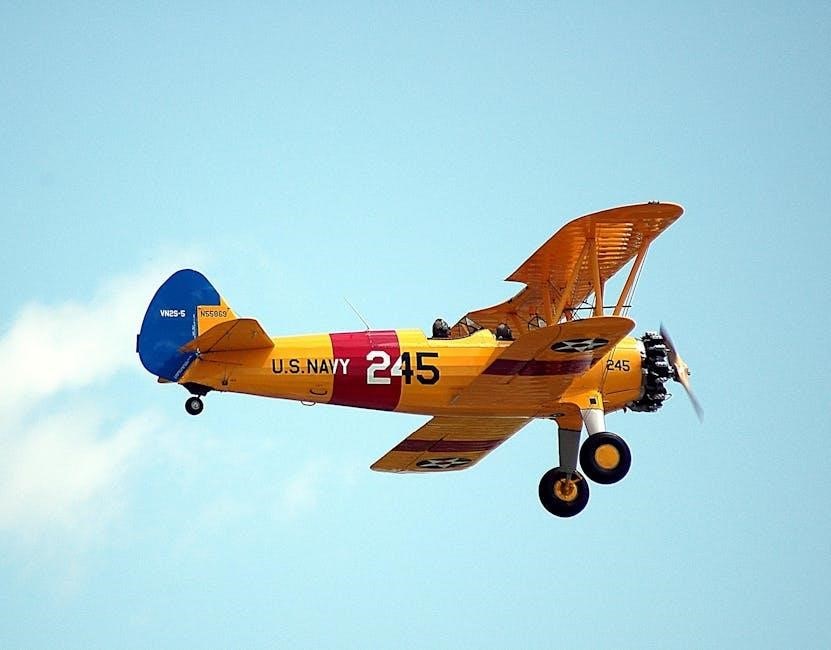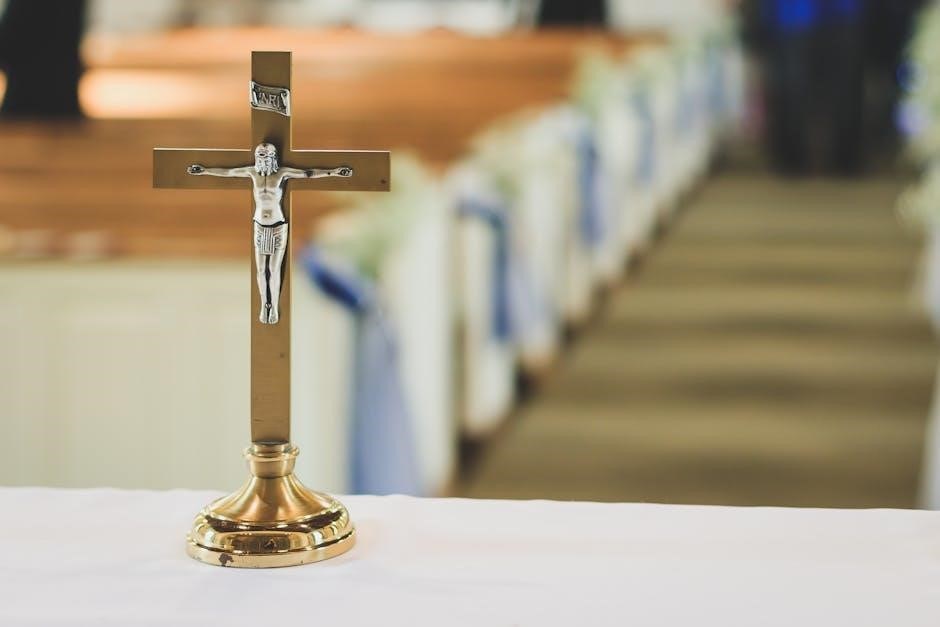Lord of the Flies Chapter 5 Questions and Answers PDF: A Comprehensive Guide
This guide provides a detailed analysis of Chapter 5, including study questions, answers, and insights into themes like leadership, fear, and civilization. Perfect for students seeking a deeper understanding of Golding’s timeless novel.
Overview of Chapter 5:
Ralph calls an assembly to address the boys’ fears and the loss of the fire, highlighting the struggle between order and savagery. The conch shell symbolizes democracy, while Jack’s ambition grows.
Key Themes:
Leadership struggles, fear of the beast, and the importance of rules dominate the chapter. Ralph’s civilized approach contrasts with Jack’s desire for power, foreshadowing future conflicts.
Study Questions:
- Why does Ralph call the assembly?
- How do Jack’s actions reflect his ambition?
- What role does the conch shell play?
Answers and Analysis:
Ralph seeks to restore order, while Jack’s hunger for power escalates tensions. The conch symbolizes democracy, but its influence wanes as fear and chaos prevail.
Chapter 5 is pivotal, exploring themes of leadership, fear, and civilization. It sets the stage for the novel’s darker themes, making it essential for understanding the boys’ descent into savagery.
Overview of Chapter 5: “Beast from the Water”
In Chapter 5, Ralph calls an assembly to address the growing fear of the “beast” and the loss of the fire. Tensions rise as Jack’s ambition becomes more apparent, challenging Ralph’s leadership. The conch shell, a symbol of order, is used to maintain democracy, but fear and chaos begin to undermine the boys’ civilized behavior. The chapter highlights the struggle between order and savagery.
Key Themes in Chapter 5
Chapter 5 explores themes of leadership, fear, and civilization. Ralph’s struggle to maintain order contrasts with Jack’s desire for power, highlighting the tension between democracy and dictatorship. Fear of the “beast” fuels superstition, while the loss of the fire symbolizes the boys’ decline into chaos. These themes underscore the conflict between savagery and civilization, central to the novel’s message.
2.1. Leadership and Power Struggles
In Chapter 5, Ralph and Jack’s leadership styles clash, revealing their differing priorities. Ralph focuses on survival and order, while Jack craves power and control through hunting. The assembly highlights Ralph’s democratic approach, but Jack’s defiance and growing ambition undermine his authority, showcasing the escalating rivalry and the boys’ shifting loyalties.
2.2. Fear and Superstition
Fear of the “beast” grips the boys, fueling superstition and chaos. Their collective anxiety leads to irrational behavior, as they seek comfort in myths rather than reason. Ralph and Jack exploit this fear to assert control, while Piggy’s rationality struggles to counteract the growing hysteria, illustrating how fear can dismantle civilized behavior and escalate conflicts among the group.
2.3. Rules and Civilization
The rules established by Ralph aim to maintain order and civility, but they begin to unravel as the boys’ primal instincts take over. The conch shell, a symbol of democracy, loses its authority when fear and greed dominate. Without adherence to rules, the island descends into chaos, highlighting the fragile nature of civilization when faced with human savagery and primal desires.

Ralph calls the assembly to address the boys’ growing fears and the loss of the fire, which has stranded them; He emphasizes the need for rules to maintain order and survive. The conch shell, once a symbol of democratic order, now struggles to hold the boys’ attention as chaos and disrespect escalate, revealing their descent into savagery and disregard for civility.
3.1. Why Ralph Calls the Assembly
Ralph calls the assembly to address the group’s growing fears and the loss of the fire, which was their only means of signaling for rescue. He aims to reestablish order and ensure the boys understand the importance of maintaining the fire and adhering to rules for their survival on the island.
3.2. The Purpose of the Meeting
The purpose of the meeting is to address the boys’ fears about the beast, discuss the loss of the fire, and reaffirm the rules necessary for their survival. Ralph aims to restore unity, ensure responsibilities are met, and prevent chaos from taking over, highlighting the importance of cooperation and maintaining civilization on the island.
Ralph and Jack: Leadership Styles in Chapter 5
Ralph’s leadership emphasizes order, responsibility, and the conch’s democratic power, focusing on survival and rescue. Jack, driven by ambition and desire for control, prioritizes hunting and power, revealing a more authoritarian style. Their conflicting approaches highlight the struggle between civilization and savagery, setting the stage for future conflicts and the island’s descent into chaos.
4.1. Ralph’s Approach to Leadership

Ralph’s leadership emphasizes democracy and order, using the conch shell to ensure fairness. He focuses on practical goals like building shelters and maintaining the fire, aiming for rescue. However, his indecisiveness and frustration grow as chaos escalates, revealing strain in his ability to lead effectively and maintain civility among the group.
4;2. Jack’s Ambition and Conflict
Jack’s ambition to lead intensifies in Chapter 5, driven by a desire for power and control. His passion for hunting and dominance clashes with Ralph’s focus on rescue and order. Jack’s frustration grows as Ralph’s leadership is questioned, leading to open conflict and a struggle for authority that further divides the group.
The Rules and Their Importance
The rules in Chapter 5 are crucial for maintaining order and civilization. They include the conch shell for speaking rights, fire upkeep, and democratic decision-making. These rules symbolize the boys’ attempt to replicate societal structures, ensuring survival and fairness. Breaking them, like letting the fire go out, leads to chaos, emphasizing their vital role in preserving the group’s moral framework and hope for rescue.
5.1. How the Rules Were Broken
The rules were broken through neglect and disregard. The fire, a critical rule for rescue, was allowed to die when the boys focused on hunting. Additionally, Jack’s disregard for the conch shell’s authority and the chaotic shouting during the assembly violated the rule of order, showcasing the boys’ growing savagery and disregard for established norms.
5.2. Consequences of Breaking the Rules
The consequences of breaking the rules were severe, leading to chaos and fear. The fire, a vital signal for rescue, was extinguished, isolating the boys further. The assembly descended into disorder, with shouting overriding the conch’s authority, highlighting the erosion of civilization and the rise of savagery. This breakdown intensified the boys’ primal fears and weakened their collective unity.
The Fire: A Symbol of Hope and Responsibility

The fire symbolizes hope for rescue and the boys’ responsibility to maintain order. Its loss in Chapter 5 represents a failure of duty and a decline in their commitment to civilization. Ralph emphasizes its importance, but the group’s negligence leads to its extinction, plunging them into darkness and despair, underscoring the fragility of their society.
6.1. The Loss of the Fire
The fire, a symbol of hope and responsibility, goes out due to the boys’ negligence while hunting. Ralph’s frustration grows as the group fails to prioritize the fire, leading to a loss of morale and signaling their declining commitment to civilization. This event highlights the boys’ inability to maintain order and previews their eventual descent into savagery.
6.2. The Impact on the Boys’ Morale
The loss of the fire deeply affects the boys’ morale, leading to frustration and despair. Without the fire, their sense of security and purpose diminishes. Ralph feels defeated, as the fire symbolized their hope for rescue. The group’s unity weakens, and fear of the unknown intensifies, accelerating their descent into savagery and further dividing the group.
The Conch Shell: A Symbol of Order
The conch shell represents democracy and order in the novel. It ensures that each boy has a chance to speak, maintaining civility and structure during assemblies. Ralph relies on it to assert his leadership, while its absence leads to chaos. The conch symbolizes the fragile balance between civilization and savagery, highlighting the importance of rules in their island society.
7.1. The Role of the Conch in the Assembly
The conch shell is used in Chapter 5 to maintain order during the assembly. Whoever holds it has the right to speak, ensuring fairness and equality. Ralph uses it to regain control, emphasizing its importance in preserving democracy. However, as tensions rise, the conch’s authority begins to wane, reflecting the boys’ growing disregard for rules and civilized behavior.
7.2. The Conch as a Representation of Democracy
The conch shell symbolizes democracy in Chapter 5, allowing equal speech for all. It represents order and civility, giving each boy a voice. However, as fear and chaos rise, the conch’s power fades, reflecting the erosion of democratic ideals. This decline mirrors the boys’ descent into savagery, highlighting the fragility of democratic structures without strong leadership and shared commitment.
Piggy and Simon: Their Reactions to Events
Piggy and Simon react with concern and insight to the unfolding chaos. Piggy fears Jack’s growing hostility and the group’s disregard for rules, while Simon begins to grasp the true nature of the beast. Their reactions highlight their unique perspectives, with Piggy advocating for reason and Simon seeking deeper truths, contrasting with the others’ escalating fear and aggression.
8.1. Piggy’s Concerns About Jack
Piggy expresses deep anxiety about Jack’s aggressive behavior and growing disregard for rules. He fears Jack’s hunger for power and its potential to destabilize the group. Piggy’s concerns highlight his understanding of the importance of leadership and order, contrasting sharply with Jack’s escalating ambition and impulsive actions, which threaten their fragile civilization.
8.2. Simon’s Insights and Fears
Simon reveals his fear that the beast might be among them, suggesting it could be a force within themselves; He expresses concern about the group’s behavior and the growing chaos, fearing their descent into savagery. Simon’s insights highlight his unique perception of reality and his understanding of the boys’ primal nature, which contrasts with their struggle to maintain civilization.
The Beast: A Source of Fear
The beast embodies the boys’ primal fears, spreading panic and paranoia. It becomes a central topic during the assembly, with the group divided over its existence. The fear of the beast reveals their deep-seated anxieties and superstitions, escalating tensions and highlighting their fragile grip on civilization. The beast’s presence underscores the island’s mysterious dangers and the boys’ vulnerabilities.

9.1. The Boys’ Fear of the Beast
The boys’ fear of the beast escalates into mass hysteria, fueled by rumors and superstition. Their primal anxieties surface, leading to chaotic behavior during the assembly. The younger boys are particularly terrified, believing the beast to be a real threat. This fear undermines Ralph’s authority and strengthens Jack’s position, as he promises protection through hunting, further dividing the group.
9.2. The Reality of the Beast
The beast, a source of terror, is revealed to be a dead parachutist, not a living creature. This reality contrasts sharply with the boys’ irrational fears, symbolizing the power of misinformation and paranoia. The true threat lies not in the beast but in the boys’ own descent into savagery, as fear drives them further from civilization and toward primal instincts.
The Political System on the Island
The island’s political system evolves into a struggle between democracy and authoritarianism. Ralph’s leadership emphasizes rules and collective decision-making, while Jack’s faction prioritizes hunting and power. The conch shell, a symbol of democracy, loses influence as fear and chaos grow. This shift reflects the boys’ gradual abandonment of civilized norms in favor of primal instincts and power struggles.
10.1. The Establishment of Rules and Roles
The boys establish rules to maintain order, with the conch shell symbolizing the right to speak. Roles are assigned based on strengths, such as hunting or tending the fire. These rules aim to preserve civility but face challenges as fear and conflicts arise, testing the fragile political structure and the boys’ ability to cooperate.
10.2. The Struggle for Power
The struggle for power intensifies as Ralph and Jack’s leadership styles clash. Ralph focuses on maintaining order, while Jack’s desire for control grows, fueled by his hunting successes. Their conflicting priorities create tension, with Jack challenging Ralph’s authority and the group’s unity beginning to fracture under the pressure of fear and ambition.
Study Questions for Chapter 5
Why does Ralph call the assembly, and what issues does he aim to address?
What role does the conch shell play in maintaining order during the meeting?
How does the loss of the fire affect the boys’ morale and Ralph’s leadership?
What does Jack’s behavior reveal about his desire for power and control?
How do Piggy and Simon react to the events, and what insights do they provide?

11.1. Multiple-Choice Questions

Who calls the assembly in Chapter 5?
a) Ralph
b) Jack
c) Piggy
d) Simon
What is the main reason for the assembly?
a) To hunt pigs
b) To discuss the beast
c) To rebuild the shelter
d) To rekindle the fire
Which object symbolizes order during the meeting?
a) The spear
b) The conch shell
c) The fire
d) The pig’s head
11.2. Short-Answer Questions
Why does Ralph decide to hold an assembly?
What issues does Ralph aim to address during the meeting?
What does the conch shell symbolize in the assembly?
How does Piggy express his concerns about Jack?
What event leads to the loss of the fire, and what are its consequences?

Answer these questions based on your reading and analysis of Chapter 5.
11.3. Essay Questions
Analyze Ralph’s leadership style and how it contrasts with Jack’s ambition in Chapter 5. Discuss the significance of the conch shell as a symbol of democracy. Explain how fear of the “beast” influences the boys’ behavior and unity. Describe the impact of the fire’s loss on the group’s morale. How does the assembly reflect the struggle between order and savagery?
Answers to Chapter 5 Questions
- Ralph calls the assembly to address fears and restore order.
- The conch shell symbolizes democracy and order among the boys.
- The fire’s loss lowers morale and highlights the group’s disorganization.
- Jack’s ambition and desire for power escalate tensions with Ralph.
- Fear of the “beast” unites the boys but also leads to chaos.
12.1. Answers to Multiple-Choice Questions
- Q: Why does Ralph call the assembly?
A: To address the boys’ fears and restore order. - Q: What is the purpose of the conch shell?
A: It symbolizes democracy and ensures each boy speaks in turn. - Q: Why does Jack hesitate to kill the piglet?
A: He is uncertain and fears failure. - Q: What happens when the conch is blown?
A: It signals the start of an assembly.
12.2. Answers to Short-Answer Questions
Ralph calls the assembly to discuss the beast and the fire, aiming to restore order. Jack feels jealous of Ralph’s leadership and resentful of his authority. The conch shell ensures order and fairness during discussions. Its breaking symbolizes the erosion of civilization. Ralph’s leadership emphasizes responsibility, while Jack’s focuses on power and hunting, highlighting their conflicting priorities.
12.3. Answers to Essay Questions
In Chapter 5, Ralph’s leadership emphasizes responsibility and order, while Jack’s prioritizes power and hunting. The conch shell symbolizes democracy, but its influence fades as fear and chaos grow. The beast represents primal fears, undermining civilization. Ralph’s call for an assembly highlights his attempt to maintain order, contrasting with Jack’s escalating ambition, which foreshadows future conflicts and the decline of civility among the boys.

Symbolism in Chapter 5
The conch shell represents democracy and order, as it grants speaking rights during assemblies. The fire symbolizes hope and rescue, its loss indicating the boys’ declining civilization. The beast embodies fear and superstition, dividing the group. The island serves as a microcosm of society, exploring savagery versus civilization, highlighting how primal instincts emerge without societal constraints. These symbols enrich the novel’s themes and conflicts.
13.1. The Island as a Microcosm of Society
The island mirrors human society, with its isolation reflecting the world’s complexities. Power struggles, fear, and rule-breaking echo real-world conflicts, showcasing how primal instincts surface without societal norms. The boys’ behavior highlights human nature’s duality, emphasizing civilization’s fragility and the ease with which savagery can prevail, making the island a symbolic representation of broader societal dynamics and challenges.
13.2. The Beast as a Symbol of Fear
The beast embodies the boys’ primal fears, symbolizing the unknown and their deep-seated anxieties. It serves as a unifying force, creating a common enemy that distracts from their internal conflicts. However, the beast also represents the fear of the “other,” reflecting human society’s tendency to scapegoat and fear what it doesn’t understand, highlighting the destructive power of unchecked terror and paranoia.
Foreshadowing in Chapter 5
Chapter 5 foreshadows future conflicts through Ralph and Jack’s escalating tensions, hinting at their eventual power struggle. The beast’s presence symbolizes the boys’ growing fear and the unraveling of their civilization. The fire’s loss and the conch’s diminishing authority also suggest a decline into chaos, previewing the novel’s darker themes and tragic events, such as Simon’s death and the boys’ descent into savagery.
14.1. Events That Foreshadow Future Conflicts
Ralph and Jack’s clash during the assembly previews their power struggle. Jack’s defiance and desire for hunting over responsibilities signal his growing ambition. The group’s fear of the beast and the breaking of rules like letting the fire go out hint at their eventual descent into chaos and savagery, foreshadowing the tragic events that will unfold on the island.
14.2. The Decline of Civilization
The boys’ disregard for rules and the conch shell’s diminishing authority mark the erosion of their civilized behavior. Ralph’s leadership is challenged, and the group’s focus shifts from survival to primal instincts. This decline mirrors the collapse of societal norms, highlighting humanity’s inherent tendency toward savagery when left unchecked, a central theme in Golding’s novel.
Connecting Chapter 5 to the Rest of the Novel
Chapter 5 sets the stage for escalating tensions between Ralph and Jack, highlighting the decline of civilization. The loss of the fire and the fear of the beast symbolize the boys’ descent into savagery. These events foreshadow the eventual breakdown of their society, serving as a catalyst for the novel’s exploration of humanity’s primal instincts and the struggle between order and chaos.
15.1. The Escalation of Tensions
In Chapter 5, the assembly reveals growing friction between Ralph and Jack. Ralph’s frustration over the fire’s loss and Jack’s defiance escalate tensions, showcasing their opposing leadership styles. This conflict mirrors the broader struggle between order and savagery, setting the stage for future power struggles and the eventual fragmentation of the group.
15.2. The Theme of Savagery vs. Civilization
Chapter 5 highlights the conflict between savagery and civilization as the boys’ behavior becomes more primal. Ralph’s focus on rules and order contrasts with Jack’s growing aggression, symbolizing the struggle between civility and instinct. The chapter underscores how fear and power dynamics erode the group’s initial attempts at democracy, revealing the inherent fragility of civilized behavior.

Chapter 5 serves as a pivotal moment, showcasing the erosion of civilization and the rise of savagery among the boys. Ralph’s leadership is challenged, and the group’s fear of the beast intensifies, highlighting the fragile balance between order and chaos. This chapter sets the stage for further conflicts, emphasizing the novel’s exploration of human nature and societal breakdown.
16.1. The Significance of Chapter 5
Chapter 5 is crucial as it highlights the escalating tensions between Ralph and Jack, symbolizing the clash between civilization and savagery. The assembly reveals the boys’ growing fear and the breakdown of rules, showcasing how quickly order can dissolve without strong leadership. This chapter underscores Golding’s exploration of human nature and the effects of isolation.
16.2. Preparing for Future Chapters
Chapter 5 sets the stage for future conflicts by deepening the rivalry between Ralph and Jack. The decline of civilization and the rise of fear and savagery are evident, foreshadowing the boys’ eventual descent into chaos. The conch’s diminished power and the beast’s lingering threat prepare readers for the escalating tensions and tragic events in subsequent chapters.




Leave a Reply
You must be logged in to post a comment.